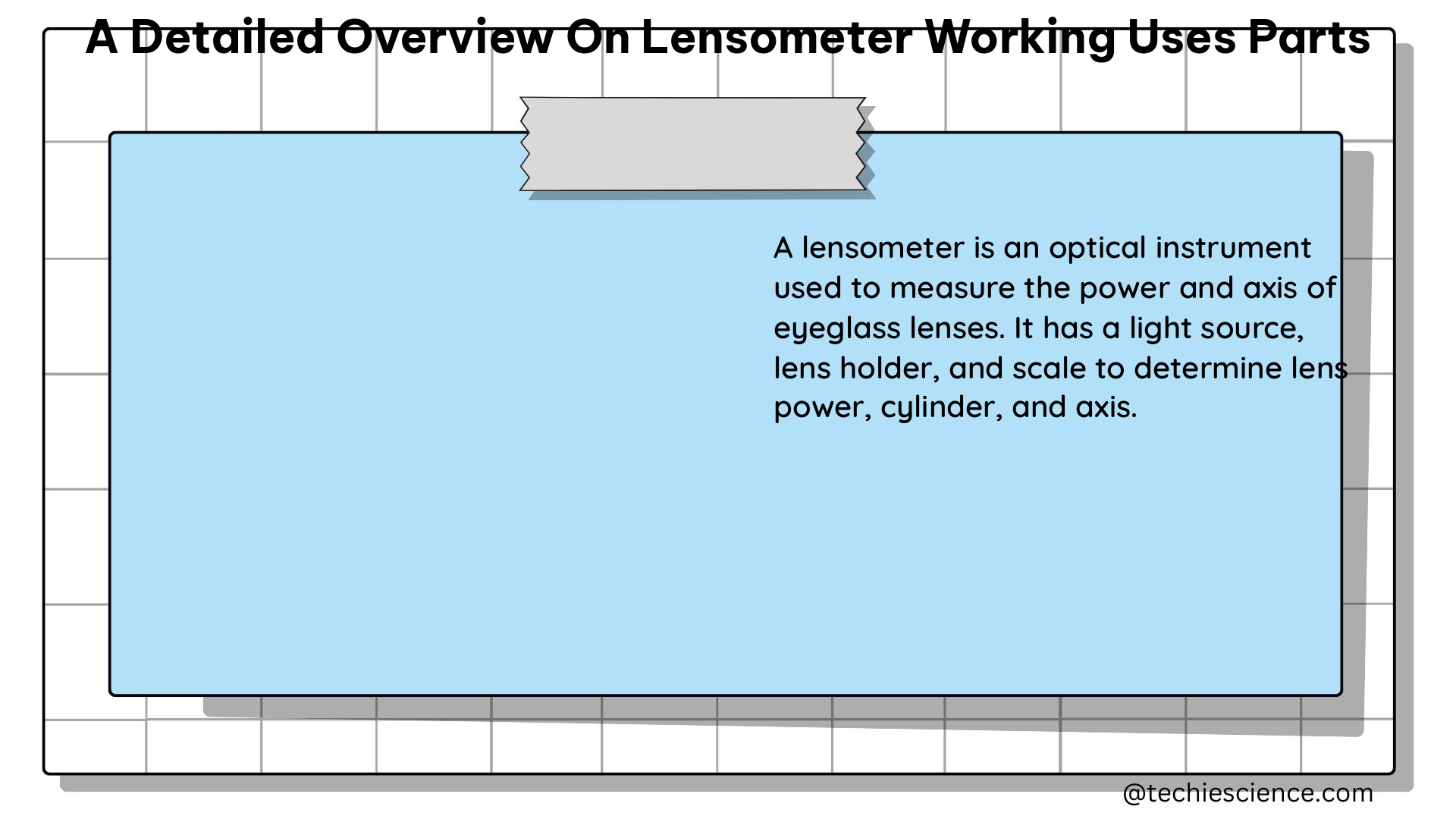A lensometer is an essential optical instrument used to measure the dioptric vertex power, optical center, cylindrical axis, and prism of a lens. It plays a crucial role in establishing and verifying a reference refractive prescription before an eye examination. The process of measuring the prescription of a refractive lens, where the lensometer compensates with a focal length that neutralizes the lens, is known as “neutralization.”
History of Lensometry
The history of lensometry dates back to the mid-19th century, with the development of the photographometer by Antoine Francois Jean Claudet in 1848. The first focimeter was introduced in 1912 by Troppman, and modern lensometers are derived from these past advances.
Types of Lensometers

There are two main types of lensometers: manual and automated.
Manual Lensometers
Manual lensometers use a battery-powered, LED illumination system to measure the precise powers of the sphere, cylinder, axis, add, and prism of a lens manually. The two most common types of manual lensometer are the American Cross and European Dot.
American Cross Lensometer
The American cross lensometer consists of a series of uniform lines located at right angles to one another. The triple thin lines are designated as the “sphere lines,” and the single thick line is the “cylinder line.”
European Dot Lensometer
The European dot lensometer consists of a series of uniform dots located at right angles to one another. A protractor grid is used to determine the cylinder axis.
Automated Lensometers
Automated lensometers are automatic instruments that measure repeatable, fast, and reliable lens prescriptions. They employ a white light and ray-trace system to measure the powers of the sphere, cylinder, axis, add, and prism of a lens in a single operation. The values of each measure are then displayed digitally and can be printed or recorded manually.
Lens Types Neutralized by Lensometers
A lensometer can neutralize various types of lenses, including:
- Single-vision lenses
- Bifocal lenses
- Trifocal lenses
- Progressive lenses
- Prismatic lenses
- Rigid gas-permeable lenses
These lenses contain four primary types of powers:
- Spherical power
- Cylindrical power
- Additions for near vision
- Prismatic power
Measurable Data from Lensometers
A lensometer can measure the following quantifiable data:
- Dioptric Vertex Power: The power of a lens measured at the vertex, or the point where the lens is closest to the eye.
- Optical Center: The point on the lens where the light rays pass through without any deviation.
- Cylindrical Axis: The orientation of the cylindrical power of the lens, measured in degrees.
- Prism: The amount of prismatic power in the lens, measured in prism diopters.
American Cross Lensometer Measurements
The American cross lensometer consists of a series of uniform lines located at right angles to one another. The triple thin lines are designated as the “sphere lines,” and the single thick line is the “cylinder line.” The intersection of these lines indicates the optical center of the lens.
European Dot Lensometer Measurements
The European dot lensometer consists of a series of uniform dots located at right angles to one another. A protractor grid is used to determine the cylinder axis, which is the orientation of the cylindrical power of the lens, measured in degrees.
Lensometer Parts and Components
A typical lensometer consists of the following parts and components:
-
Illumination System: The illumination system is responsible for providing the light source used to measure the lens. This can be a battery-powered, LED-based system in manual lensometers or a white light source in automated lensometers.
-
Lens Holder: The lens holder is the part of the lensometer where the lens to be measured is placed. It is designed to securely hold the lens in a specific orientation.
-
Reticle: The reticle is the pattern of lines or dots (depending on the lensometer type) that is projected onto the lens being measured. This pattern is used to determine the various lens parameters.
-
Focusing Mechanism: The focusing mechanism allows the user to adjust the distance between the lens and the reticle, enabling the lensometer to accurately measure the lens power.
-
Measurement Scales: The measurement scales, typically located on the lensometer, are used to read and record the various lens parameters, such as sphere, cylinder, axis, and prism.
-
Digital Display: Automated lensometers often feature a digital display that shows the measured lens parameters, making it easier to record the data.
-
Printer Interface: Some lensometers may have a printer interface, allowing the measured lens data to be printed for record-keeping or patient records.
-
Calibration Mechanism: Lensometers require periodic calibration to ensure accurate measurements. The calibration mechanism, which may include test lenses or other calibration tools, is used to verify and adjust the lensometer’s performance.
Conclusion
A lensometer is a crucial optical instrument used to measure the dioptric vertex power, optical center, cylindrical axis, and prism of a lens. It plays a vital role in establishing and verifying a reference refractive prescription before an eye examination. Understanding the history, types, lens neutralization capabilities, measurable data, and the various parts and components of a lensometer is essential for anyone working in the field of optics and vision care.
References
- Lensometry – StatPearls – NCBI Bookshelf
- Lensometry – EyeWiki
- Lensometers | PPT – SlideShare
- The focimeter— measuring the power of eyeglass lenses
- Lensometer – an overview | ScienceDirect Topics

Hi, I am Sanchari Chakraborty. I have done Master’s in Electronics.
I always like to explore new inventions in the field of Electronics.
I am an eager learner, currently invested in the field of Applied Optics and Photonics. I am also an active member of SPIE (International society for optics and photonics) and OSI(Optical Society of India). My articles are aimed at bringing quality science research topics to light in a simple yet informative way. Science has been evolving since time immemorial. So, I try my bit to tap into the evolution and present it to the readers.
Let’s connect through